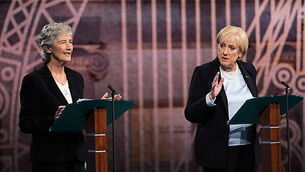Not possible to say what blow caused fatal injury to Dylan McCarthy outside Kildare pub, jury hears

Ryan Dunne
It is not possible to determine whether a punch or kick caused the fatal injury that led to the death of Dylan McCarthy, a Central Criminal Court jury has heard.
State pathologist Dr Heidi Okkers on Thursday told the jury that 29-year-old Mr McCarthy died as the result of a traumatic head injury and spinal injury caused by blunt force trauma, but she was unable to determine what blow caused the injury.
It is the State’s case that Mr McCarthy died following an incident outside a public house in a Kildare town in which he received punches from Sean Kavanagh (26) and Calvin Dunne (24), before he received “a vicious kick” to the head from Mr Dunne while he was attempting to get up off the ground.
An eyewitness told the jury that there was “a loud thud” like someone “kicking a football” when Mr McCarthy was struck in the head.
The jury has been told that both men have claimed they were acting in self-defence and that Mr McCarthy was himself “involved in violence” on the night.
Mr Kavanagh (26) with an address at St Mary’s Lane, Church Avenue, and Mr Dunne (24) of Abbey View, both in Monasterevin, Co Kildare, have pleaded not guilty to the murder of Mr McCarthy on or about August 22nd, 2022.
They have also pleaded not guilty to violent disorder on August 21st, 2022, at Dublin Road, Monasterevin, while Mr Kavanagh has pleaded not guilty to a charge of assault causing harm on Eamon McCarthy, the father of the deceased, on the same date and at the same location.
Dr Okkers gave evidence to counsel for the Director of Public Prosecutions, Seoirse O’Dúnlaing SC, that Mr McCarthy suffered a haemorrhage to the area from his right ear to the top of his head. She said he also suffered a haemorrhage on his left temporal scalp and fractures to the area by the cheekbone.
She explained that there was bleeding in between the membrane covering the brain and the brain surface, while there was extensive bleeding at the base of the brain.
Dr Okkers said Mr McCarthy’s brain weighed 1.72 kilogrammes, meaning it was significantly swollen. There was also a haemorrhage over the left side of his jaw and neck. She said there was extensive haemorrhaging in the tissue around his left cervical spine which extended to the base of the brain.
Dr Okkers also referenced a report by Dr Francesca Brett, who found evidence of hypoxic brain damage due to a lack of oxygen to the brain. Dr Brett found that the “most striking abnormality” was to the spinal cord, where she observed that the spinal cord cells were dying. Dr Brett found that a tear to the vertebral artery caused internal bleeding that deprived the brain of oxygen.
Dr Okkers said that Mr McCarthy suffered multiple bruises to his face, head and neck, with the bruising consistent with blunt force trauma and in keeping with the alleged assault.
Dr Okkers said that, from what she observed on CCTV footage of the incident, it was difficult to say which blow caused the injury, but it could have been either a punch or a kick, while further blows could have exacerbated the injury and contributed to the tearing of the artery.
She said this injury can be caused either by direct trauma to the area or it happens when there is an impact to the head that causes the head to hyperextend and rotate. She explained that this occurs when there is either a punch or kick to the face that causes the head to go back and rotate, with this sudden movement backwards causing the tear.
Dr Okkers told the jury that the cause of death was the result of a traumatic head injury and spinal injury caused by blunt force trauma. She also said that she was unable to determine which blow caused the injury.
The trial continues next Monday before Ms Justice Caroline Biggs and the jury of 10 men and two women.









